Thomas Drugman
BASE TTS: Lessons from building a billion-parameter Text-to-Speech model on 100K hours of data
Feb 15, 2024



Abstract:We introduce a text-to-speech (TTS) model called BASE TTS, which stands for $\textbf{B}$ig $\textbf{A}$daptive $\textbf{S}$treamable TTS with $\textbf{E}$mergent abilities. BASE TTS is the largest TTS model to-date, trained on 100K hours of public domain speech data, achieving a new state-of-the-art in speech naturalness. It deploys a 1-billion-parameter autoregressive Transformer that converts raw texts into discrete codes ("speechcodes") followed by a convolution-based decoder which converts these speechcodes into waveforms in an incremental, streamable manner. Further, our speechcodes are built using a novel speech tokenization technique that features speaker ID disentanglement and compression with byte-pair encoding. Echoing the widely-reported "emergent abilities" of large language models when trained on increasing volume of data, we show that BASE TTS variants built with 10K+ hours and 500M+ parameters begin to demonstrate natural prosody on textually complex sentences. We design and share a specialized dataset to measure these emergent abilities for text-to-speech. We showcase state-of-the-art naturalness of BASE TTS by evaluating against baselines that include publicly available large-scale text-to-speech systems: YourTTS, Bark and TortoiseTTS. Audio samples generated by the model can be heard at https://amazon-ltts-paper.com/.
A Comparative Analysis of Pretrained Language Models for Text-to-Speech
Sep 04, 2023Abstract:State-of-the-art text-to-speech (TTS) systems have utilized pretrained language models (PLMs) to enhance prosody and create more natural-sounding speech. However, while PLMs have been extensively researched for natural language understanding (NLU), their impact on TTS has been overlooked. In this study, we aim to address this gap by conducting a comparative analysis of different PLMs for two TTS tasks: prosody prediction and pause prediction. Firstly, we trained a prosody prediction model using 15 different PLMs. Our findings revealed a logarithmic relationship between model size and quality, as well as significant performance differences between neutral and expressive prosody. Secondly, we employed PLMs for pause prediction and found that the task was less sensitive to small models. We also identified a strong correlation between our empirical results and the GLUE scores obtained for these language models. To the best of our knowledge, this is the first study of its kind to investigate the impact of different PLMs on TTS.
Controllable Emphasis with zero data for text-to-speech
Jul 13, 2023Abstract:We present a scalable method to produce high quality emphasis for text-to-speech (TTS) that does not require recordings or annotations. Many TTS models include a phoneme duration model. A simple but effective method to achieve emphasized speech consists in increasing the predicted duration of the emphasised word. We show that this is significantly better than spectrogram modification techniques improving naturalness by $7.3\%$ and correct testers' identification of the emphasized word in a sentence by $40\%$ on a reference female en-US voice. We show that this technique significantly closes the gap to methods that require explicit recordings. The method proved to be scalable and preferred in all four languages tested (English, Spanish, Italian, German), for different voices and multiple speaking styles.
eCat: An End-to-End Model for Multi-Speaker TTS & Many-to-Many Fine-Grained Prosody Transfer
Jun 20, 2023Abstract:We present eCat, a novel end-to-end multispeaker model capable of: a) generating long-context speech with expressive and contextually appropriate prosody, and b) performing fine-grained prosody transfer between any pair of seen speakers. eCat is trained using a two-stage training approach. In Stage I, the model learns speaker-independent word-level prosody representations in an end-to-end fashion from speech. In Stage II, we learn to predict the prosody representations using the contextual information available in text. We compare eCat to CopyCat2, a model capable of both fine-grained prosody transfer (FPT) and multi-speaker TTS. We show that eCat statistically significantly reduces the gap in naturalness between CopyCat2 and human recordings by an average of 46.7% across 2 languages, 3 locales, and 7 speakers, along with better target-speaker similarity in FPT. We also compare eCat to VITS, and show a statistically significant preference.
Computer-assisted Pronunciation Training -- Speech synthesis is almost all you need
Jul 02, 2022
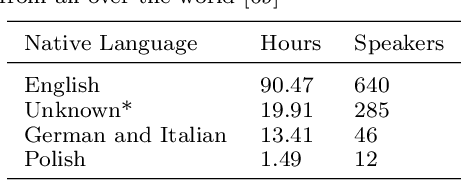


Abstract:The research community has long studied computer-assisted pronunciation training (CAPT) methods in non-native speech. Researchers focused on studying various model architectures, such as Bayesian networks and deep learning methods, as well as on the analysis of different representations of the speech signal. Despite significant progress in recent years, existing CAPT methods are not able to detect pronunciation errors with high accuracy (only 60\% precision at 40\%-80\% recall). One of the key problems is the low availability of mispronounced speech that is needed for the reliable training of pronunciation error detection models. If we had a generative model that could mimic non-native speech and produce any amount of training data, then the task of detecting pronunciation errors would be much easier. We present three innovative techniques based on phoneme-to-phoneme (P2P), text-to-speech (T2S), and speech-to-speech (S2S) conversion to generate correctly pronounced and mispronounced synthetic speech. We show that these techniques not only improve the accuracy of three machine learning models for detecting pronunciation errors but also help establish a new state-of-the-art in the field. Earlier studies have used simple speech generation techniques such as P2P conversion, but only as an additional mechanism to improve the accuracy of pronunciation error detection. We, on the other hand, consider speech generation to be the first-class method of detecting pronunciation errors. The effectiveness of these techniques is assessed in the tasks of detecting pronunciation and lexical stress errors. Non-native English speech corpora of German, Italian, and Polish speakers are used in the evaluations. The best proposed S2S technique improves the accuracy of detecting pronunciation errors in AUC metric by 41\% from 0.528 to 0.749 compared to the state-of-the-art approach.
Simple and Effective Multi-sentence TTS with Expressive and Coherent Prosody
Jun 29, 2022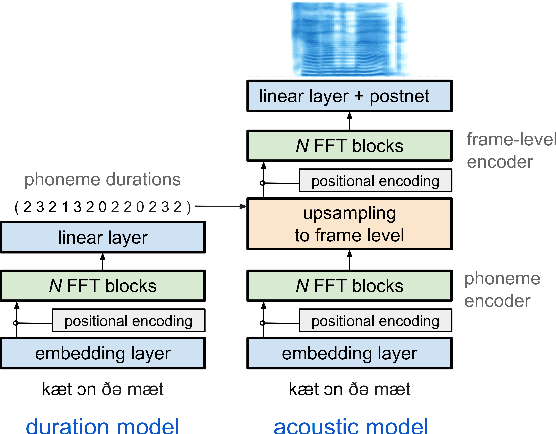
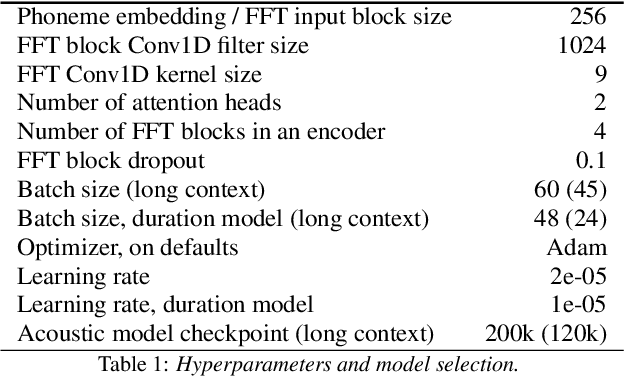

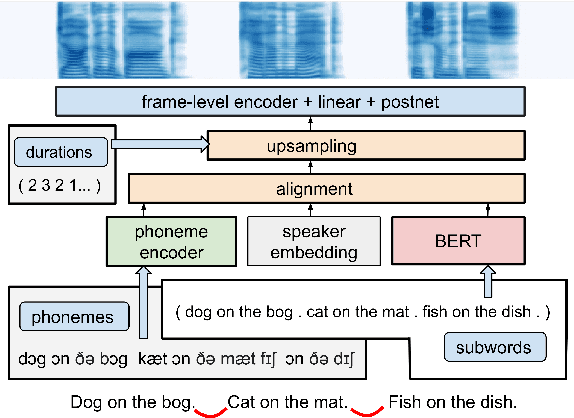
Abstract:Generating expressive and contextually appropriate prosody remains a challenge for modern text-to-speech (TTS) systems. This is particularly evident for long, multi-sentence inputs. In this paper, we examine simple extensions to a Transformer-based FastSpeech-like system, with the goal of improving prosody for multi-sentence TTS. We find that long context, powerful text features, and training on multi-speaker data all improve prosody. More interestingly, they result in synergies. Long context disambiguates prosody, improves coherence, and plays to the strengths of Transformers. Fine-tuning word-level features from a powerful language model, such as BERT, appears to profit from more training data, readily available in a multi-speaker setting. We look into objective metrics on pausing and pacing and perform thorough subjective evaluations for speech naturalness. Our main system, which incorporates all the extensions, achieves consistently strong results, including statistically significant improvements in speech naturalness over all its competitors.
Expressive, Variable, and Controllable Duration Modelling in TTS
Jun 28, 2022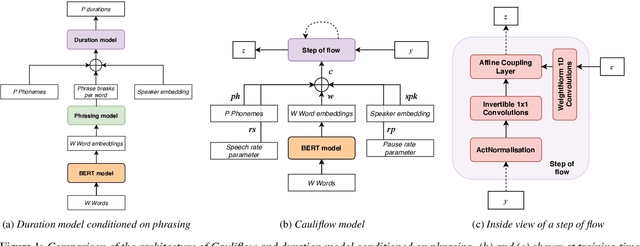


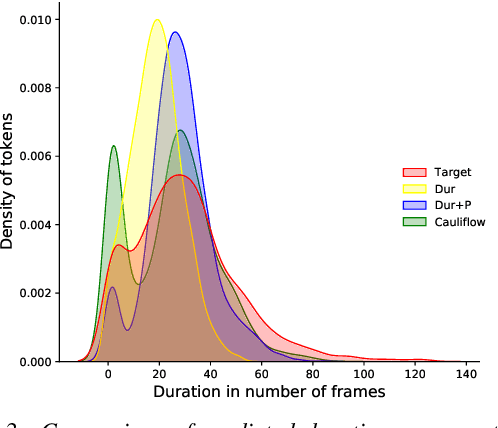
Abstract:Duration modelling has become an important research problem once more with the rise of non-attention neural text-to-speech systems. The current approaches largely fall back to relying on previous statistical parametric speech synthesis technology for duration prediction, which poorly models the expressiveness and variability in speech. In this paper, we propose two alternate approaches to improve duration modelling. First, we propose a duration model conditioned on phrasing that improves the predicted durations and provides better modelling of pauses. We show that the duration model conditioned on phrasing improves the naturalness of speech over our baseline duration model. Second, we also propose a multi-speaker duration model called Cauliflow, that uses normalising flows to predict durations that better match the complex target duration distribution. Cauliflow performs on par with our other proposed duration model in terms of naturalness, whilst providing variable durations for the same prompt and variable levels of expressiveness. Lastly, we propose to condition Cauliflow on parameters that provide an intuitive control of the pacing and pausing in the synthesised speech in a novel way.
CopyCat2: A Single Model for Multi-Speaker TTS and Many-to-Many Fine-Grained Prosody Transfer
Jun 27, 2022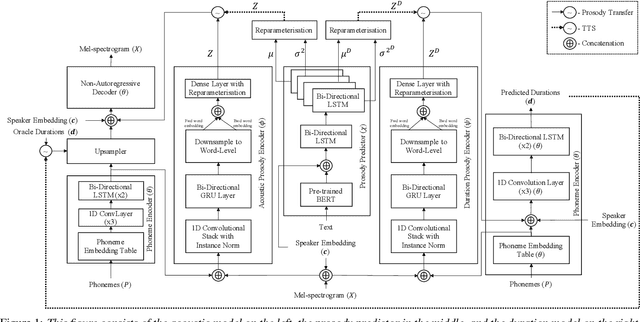

Abstract:In this paper, we present CopyCat2 (CC2), a novel model capable of: a) synthesizing speech with different speaker identities, b) generating speech with expressive and contextually appropriate prosody, and c) transferring prosody at fine-grained level between any pair of seen speakers. We do this by activating distinct parts of the network for different tasks. We train our model using a novel approach to two-stage training. In Stage I, the model learns speaker-independent word-level prosody representations from speech which it uses for many-to-many fine-grained prosody transfer. In Stage II, we learn to predict these prosody representations using the contextual information available in text, thereby, enabling multi-speaker TTS with contextually appropriate prosody. We compare CC2 to two strong baselines, one in TTS with contextually appropriate prosody, and one in fine-grained prosody transfer. CC2 reduces the gap in naturalness between our baseline and copy-synthesised speech by $22.79\%$. In fine-grained prosody transfer evaluations, it obtains a relative improvement of $33.15\%$ in target speaker similarity.
Distribution augmentation for low-resource expressive text-to-speech
Feb 19, 2022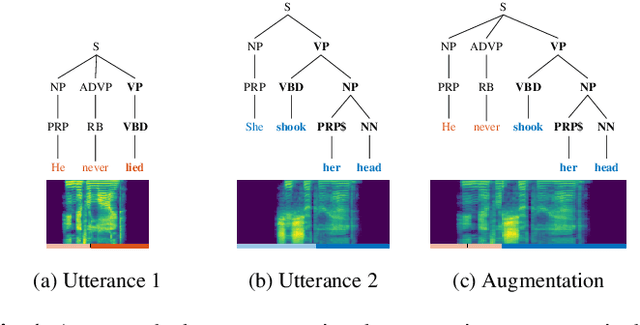
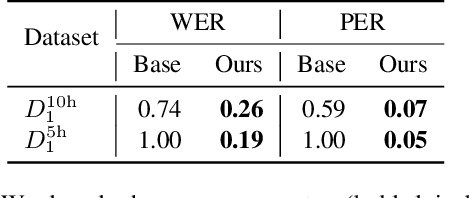
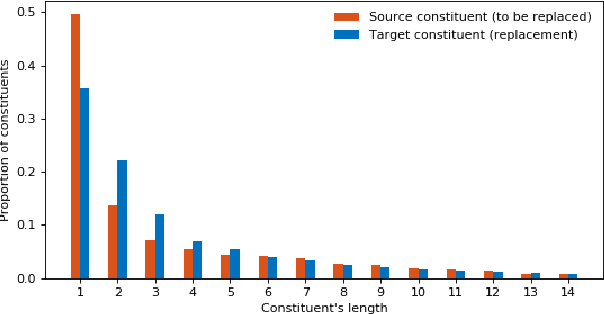

Abstract:This paper presents a novel data augmentation technique for text-to-speech (TTS), that allows to generate new (text, audio) training examples without requiring any additional data. Our goal is to increase diversity of text conditionings available during training. This helps to reduce overfitting, especially in low-resource settings. Our method relies on substituting text and audio fragments in a way that preserves syntactical correctness. We take additional measures to ensure that synthesized speech does not contain artifacts caused by combining inconsistent audio samples. The perceptual evaluations show that our method improves speech quality over a number of datasets, speakers, and TTS architectures. We also demonstrate that it greatly improves robustness of attention-based TTS models.
Multi-Scale Spectrogram Modelling for Neural Text-to-Speech
Jun 29, 2021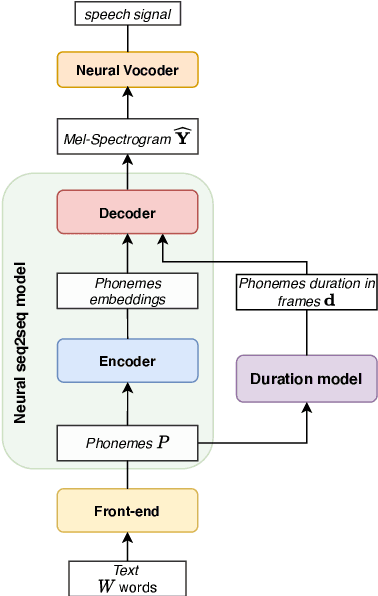
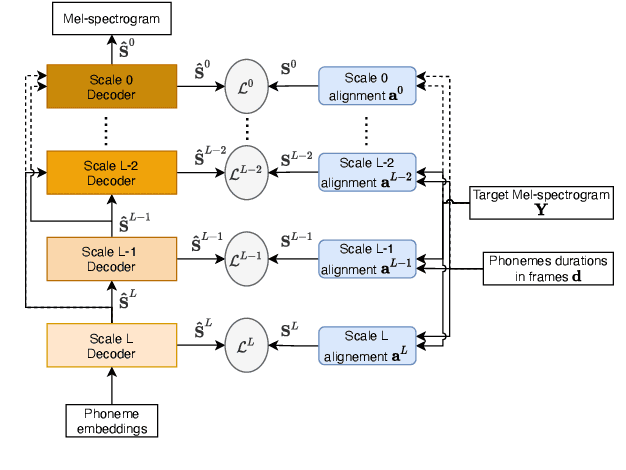
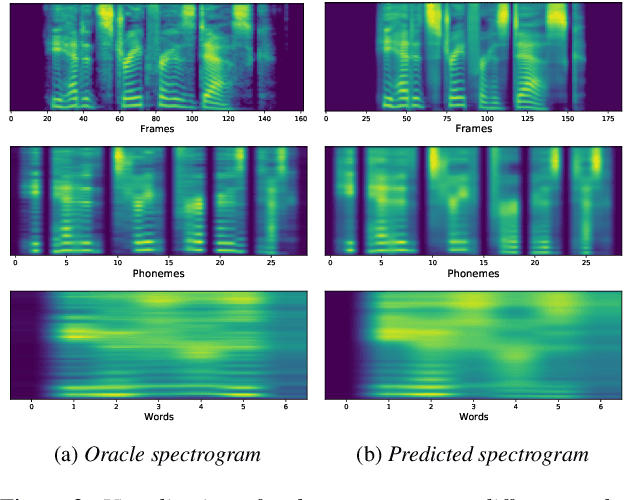
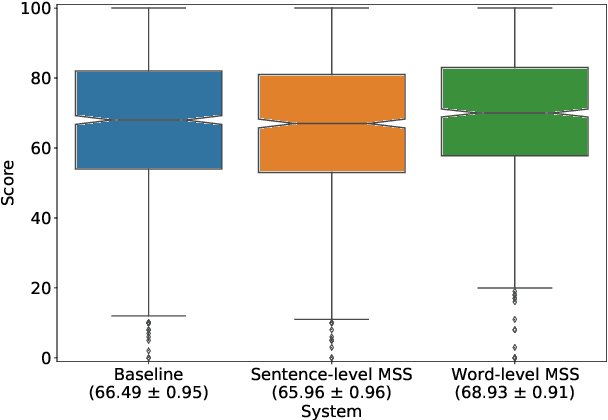
Abstract:We propose a novel Multi-Scale Spectrogram (MSS) modelling approach to synthesise speech with an improved coarse and fine-grained prosody. We present a generic multi-scale spectrogram prediction mechanism where the system first predicts coarser scale mel-spectrograms that capture the suprasegmental information in speech, and later uses these coarser scale mel-spectrograms to predict finer scale mel-spectrograms capturing fine-grained prosody. We present details for two specific versions of MSS called Word-level MSS and Sentence-level MSS where the scales in our system are motivated by the linguistic units. The Word-level MSS models word, phoneme, and frame-level spectrograms while Sentence-level MSS models sentence-level spectrogram in addition. Subjective evaluations show that Word-level MSS performs statistically significantly better compared to the baseline on two voices.
 Add to Chrome
Add to Chrome Add to Firefox
Add to Firefox Add to Edge
Add to Edge